Cn-down > Domestic news > News content
2023-04-23 来源:金绒 浏览量:1753
summary
The market price remained stable this week.
Since mid March, there has been a significant improvement in the supply of duck seedlings, and the current estimated supply of commercial substitute duck seedlings nationwide is within the range of "11.3 million feathers/day". With the increase in meat duck production, the price of duck feathers has recently weakened, but currently, meat duck profits mainly rely on by-products, so the intention of upstream price increases is obvious.
Due to high prices, many clothing companies have started their down procurement late and in small quantities this year. However, customs data shows that the import quantity of down and feather in March this year hit a record, not only doubling year-on-year, but also far exceeding the export quantity of that month. The emergence of a deficit may affect the domestic down market.
Climate models show that the global El Ni ñ o phenomenon will reappear later this year. Scholars have stated that "if El Ni ñ o does indeed return, then 2023 may be the hottest year on record." Data shows that March, which has just passed, was the "second warmest March" in 174 years, second only to 2016, which was the "hottest year on record.
Exchange rate of USD to RMB: 6.8679
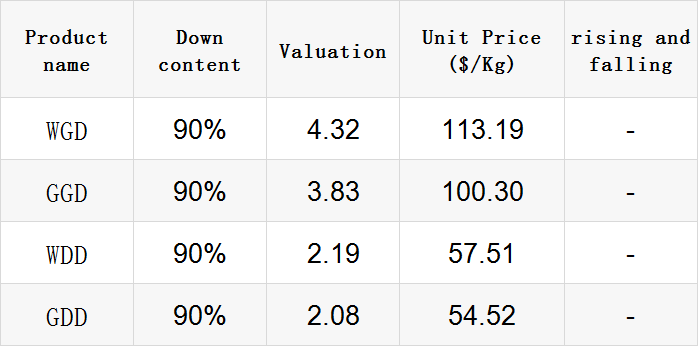
Exchange rate of USD to RMB: 6.8814
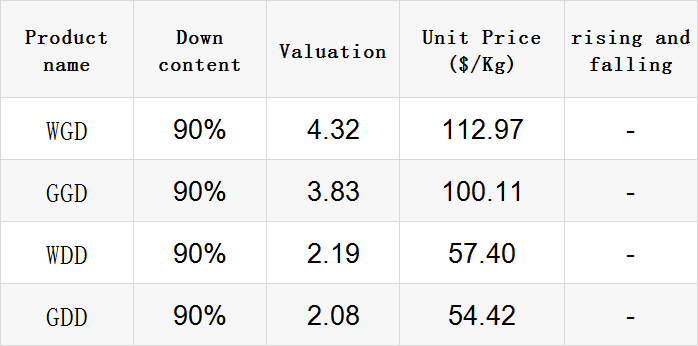
Exchange rate of USD to RMB: 6.8731
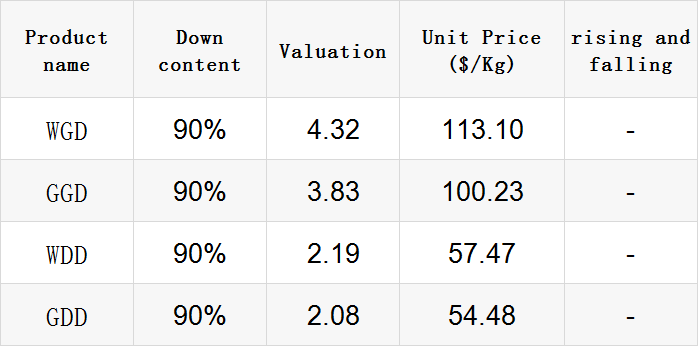
Exchange rate of USD to RMB: 6.8987

Exchange rate of USD to RMB: 6.8752
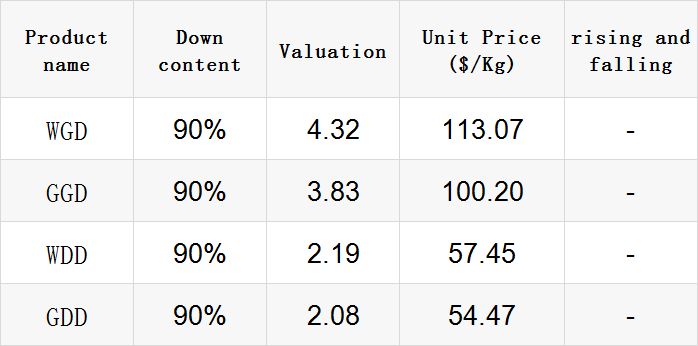
good news
Recently, Anhui Huaying Xintang Down Co., Ltd. exported a batch of washed down feathers to Vietnam. With the "economic passport" of the ASEAN certificate of origin, the tariff rate of this batch of goods directly reduced from 7.5% to zero after entering Vietnam.
Chen Tao, the head of the company's comprehensive management department, said, "We are a down and feather export enterprise, and Southeast Asia has always been the company's main export market."

He stated that the exported products meet the requirements of the preferential tax rate category change in the China ASEAN Free Trade Agreement, and therefore enjoy zero tariff treatment in the ASEAN market. "With the support of favorable policies, our related products exported to Southeast Asia have increased by over 40% year-on-year since the beginning of this year."
Wang Haiqing, Director of the Customs Tariff Department of Hefei Customs, introduced that in order to help relevant enterprises make full use of the preferential policies of origin, the customs has launched the "Hechang 2023" special action, conducting on-site research on key foreign trade enterprises by industry, and targeting the large export volume of down and feather in the China ASEAN Free Trade Agreement as a key assistance target.
The home textile industry in China is a large market. According to data from Euromonitor International and the China Home Textile Association, the market size of China's home textile industry has reached over 200 billion yuan. In recent years, while maintaining a large industry scale, the home textile industry has undergone new changes in market demand.
According to research data from Brose, with the improvement of consumer purchasing power, the frequency of home textile consumption by Chinese consumers has doubled in the past decade, shifting from durable goods to fast moving consumer goods and from low-frequency consumption to high-frequency consumption.
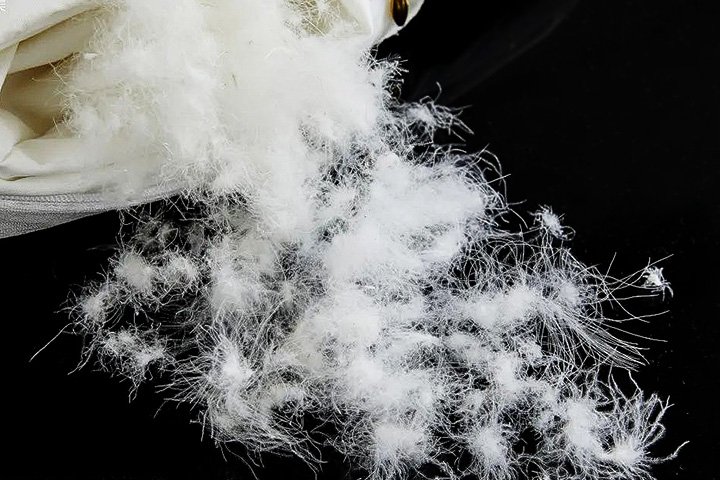
Based on data from various e-commerce platforms, the search volume for various categories of home textile products such as duvet, cowhide mats, and silk embroidery has increased significantly compared to the same period last year. The willingness of the public to upgrade and replace products with better raw materials and better sleep experience has increased.
I am willing to pay for a more comfortable bedding experience, "said Han Junwen, who is shopping for home textile products in the mall." I pay great attention to the quality of my sleep. When choosing bedding, I pay special attention to the fabric, softness, and breathability of the products, and try to create a comfortable sleeping environment for myself as much as possible。"
bad news
On March 28th, the Shandong Duck Breeding Alliance quoted 7.3 yuan per duck, but by April 14th, this figure had become 3.2 yuan per duck. The market situation has undergone a sudden change, with a drop of nearly 60% in half a month and approaching the cost line of farmers. And not only the duck seedlings, but also the entire meat duck product line is reducing prices.
Liu Changsheng, Chairman of the Shandong Duck Breeding Alliance, stated that since April, duck seedlings have experienced a cliff like decline. On the one hand, the supply has rapidly increased, increasing from a daily output of 8 million to over 10 million; On the other hand, there is insufficient improvement on the demand side, making it difficult to support the high price of duck seedlings.
In terms of listed companies, the relevant person in charge of ST Huaying stated, "The prices of the company's products are better than outside. Currently, the market supply exceeds demand, and the sales situation is not ideal. In previous years, March and April were already off-season, and May will improve. This year's off-season may last longer, and it is expected that the market will improve around June."
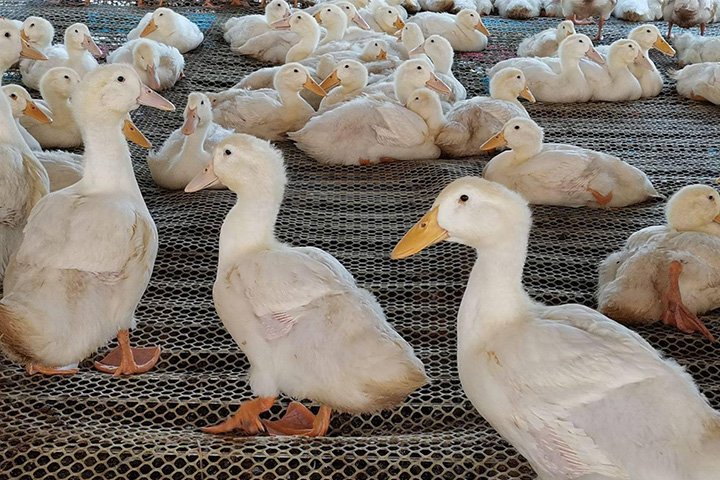
Looking at the end consumer market again, after the epidemic, the recovery of consumption was weaker than expected, coupled with low pork prices, making it difficult to reverse the short-term weakness of the industry. Liu Changsheng said, "The market uncertainty in the second half of the year is rapidly increasing, and the situation will undergo significant changes."
He suggested that farmers need to promptly and quickly eliminate outdated production capacity, reduce the number of molting and extended breeding. Our company originally planned to eliminate about 200000 breeding ducks, but now we have decided to eliminate about 270000 ducks in Inner Mongolia and 80000 ducks in Linqu starting this month, totaling about 350000 ducks."
Zhou Shaojie, a duck farmer in Weifang, said that the production of duck seedlings in the entire market has indeed increased. For the future price of duck seedlings, he believes that "there should continue to be a slight decline, but it should not fall to the price of 1-2 yuan/piece of cabbage like during the epidemic." He is also preparing to further phase out the elderly and low yield duck populations.
On April 13th local time, the US Climate Center (NOAA) released the "El Ni ñ o Observation", predicting that the El Ni ñ o phenomenon will form earlier than previously expected.
The weather forecaster stated, "Although we are still in a neutral stage (there is no El Ni ñ o or La Ni ñ a phenomenon at this time), there is a 62% chance that the El Ni ñ o phenomenon will develop between May and July."
In fact, NOAA has also predicted that the probability of El Ni ñ o developing into autumn exceeds 80%, and the probability of a strong El Ni ñ o phenomenon (Ni ñ o-3.4 greater than 1.5 ° C) occurring is about four out of ten.
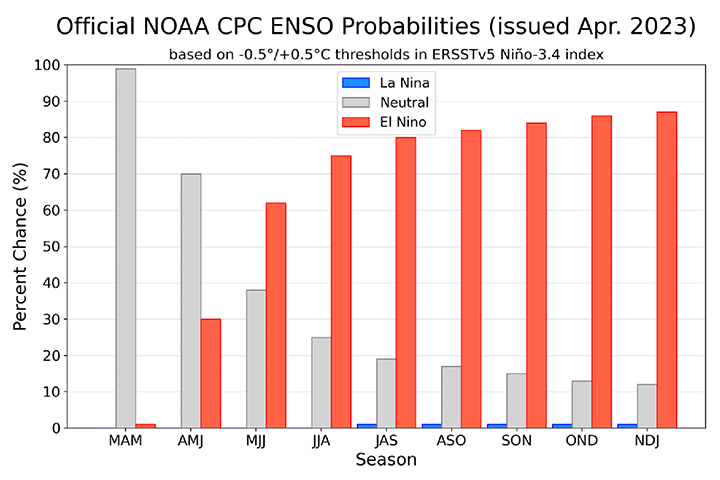
This is because the sea surface temperature along the coast of Peru approached record high temperatures in March, which often occurred before larger El Ni ñ o events. Although this is not always the case.
When El Ni ñ o or La Ni ñ a occurs in the tropical Pacific, they will affect in a specific way, with winter being the strongest. Generally speaking, the hottest year of any decade will be El Ni ñ o, while the coldest year will be La Ni ñ a.
Global warming means that if the El Ni ñ o phenomenon develops this year, it will increase the likelihood of global temperatures reaching historic highs.
With the Federal Reserve continuing to tighten monetary policy and the credit squeeze caused by the US banking crisis, the wave of corporate bankruptcies in the United States may already be on the way.
Bob Nardelli, former CEO of Home Depot, a US home retail giant, recently warned that more corporate bankruptcies will hit the US economy. He also accused US lawmakers of delaying an agreement on the debt ceiling issue.
"I think we will see a lot of enterprises go bankrupt. For example, bedding and other industries. Wal Mart not only layoffs, but also closed stores; Amazon closed its distribution center. Therefore, I think this is a very complicated information." said Nadeli.

Undoubtedly, the days for American companies are becoming increasingly difficult. UBS analysts recently warned that over 50000 retail stores in the United States may be permanently closed within the next five years, with approximately 14000 of the flexible line companies selling "soft" goods such as clothing and bedding closing.
March has always been an important period in the US home textile market. Retailers usually visit suppliers' showrooms and negotiate business during the New York Spring Home Textile Market Week in March, placing orders for the autumn and year-end peak sales periods.
This year's Spring Home Textile Market Week, the common topic for suppliers and retailers is to discuss when business can return to near normal levels. After communication, everyone seems to have reached a new consensus that retailers will purchase new goods when the spring of 2024 approaches, and no later than the end of spring.
 热门排行
中国三大羽绒生产基地之—广东吴川
全球最奢侈羽绒服排行
一件羽绒服需要多少只鸭子的羽绒?
飞丝是什么?能代替羽绒?别被骗了,三种方法让你告别假羽绒服!
2017羽绒原料价格一路上涨,究竟为何?
你的羽绒服为什么钻绒?涨知识了
羽绒被的价格一般是多少 通过成本看羽绒被价格
中国羽绒服四大品牌调查:到底谁才是最强王者?
羽绒金网:羽毛、羽绒、毛绒计价
《羽绒羽毛》、《羽绒羽毛检验方法》新版标准发布,2017年7月1日实施
热门排行
中国三大羽绒生产基地之—广东吴川
全球最奢侈羽绒服排行
一件羽绒服需要多少只鸭子的羽绒?
飞丝是什么?能代替羽绒?别被骗了,三种方法让你告别假羽绒服!
2017羽绒原料价格一路上涨,究竟为何?
你的羽绒服为什么钻绒?涨知识了
羽绒被的价格一般是多少 通过成本看羽绒被价格
中国羽绒服四大品牌调查:到底谁才是最强王者?
羽绒金网:羽毛、羽绒、毛绒计价
《羽绒羽毛》、《羽绒羽毛检验方法》新版标准发布,2017年7月1日实施
 推荐阅读
“吴川力量”助中国羽绒接轨世界
中国三大羽绒生产基地之—广东吴川
中羽协第二期新国标培训班 在“羽绒之乡”广东吴川成功举办
羽绒之乡:贵港桥圩镇将打造旅游休闲特色小镇
广西贵港桥圩镇:打造中国羽绒休闲旅游特色小镇
羽绒金网:羽毛、羽绒、毛绒计价
羽绒别急着收 中央气象台发布寒潮蓝色预警 部分地区降温超12℃
上海消保委检测 千元鹅绒被用鸭毛绒填充
冻哭丨降温10℃!鸡年首个寒潮预警来袭,你准备好了吗?
传统羽绒产业如何实现转型升级?四川玉泉镇产业集群发展
推荐阅读
“吴川力量”助中国羽绒接轨世界
中国三大羽绒生产基地之—广东吴川
中羽协第二期新国标培训班 在“羽绒之乡”广东吴川成功举办
羽绒之乡:贵港桥圩镇将打造旅游休闲特色小镇
广西贵港桥圩镇:打造中国羽绒休闲旅游特色小镇
羽绒金网:羽毛、羽绒、毛绒计价
羽绒别急着收 中央气象台发布寒潮蓝色预警 部分地区降温超12℃
上海消保委检测 千元鹅绒被用鸭毛绒填充
冻哭丨降温10℃!鸡年首个寒潮预警来袭,你准备好了吗?
传统羽绒产业如何实现转型升级?四川玉泉镇产业集群发展